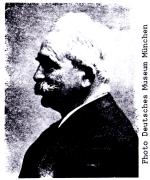| Born of Holstein landowners on the coast of the North Sea, Otto Mohr
became one of Europe's most decorated engineers of the 19th
century. Early in his career, while working for the railroads in
Hannover and Oldenburg, he designed some of the first steel trusses as
well as some of the most renowned bridges in Germany. During those
years, Mohr also began his theoretical work in mechanics and strength of
materials.
At 32, Otto Mohr became an educator, first as professor of mechanics at the Stuttgart Polytechnikum and, later, at Dresden Polytechnikum. Despite an unpolished delivery, his lectures were well received by students because of their simplicity, clarity, and conciseness. Being both a theoretician and practicing engineer, Mohr knew his subject thoroughly and was always able to bring something fresh and interesting to his students' attention. |
 |
In addition to a lone textbook, Mohr published many research papers on the theory of structures and strength of materials. Graphical solutions to specific problems were a common theme in many of them. Borrowing upon earlier work by Karl Culmann, he expanded the graphical representation of stress about a point to three dimensions. Later, using the "circles of stress" with which his name is now commonly associated, Mohr developed the first theory of strength based on shearing stresses. Following retirement from the Polytechnikum, Mohr remained in the Dresden area where he continued his scientific work until his death. |
|
From History of Strength of Materials, by S.P. Timoshenko, McGraw-Hill, 1953.
The famous German civil engineer Otto Christian Mohr was both a theoretician and a practical designer. He was a professor at the Stuttgart Polytechnikum and later at the Dresden Polytechnikum. He developed the circle of stress in 1882. The circle is also described in Mohrís book. Mohr made numerous contributions to the theory of structures, including the Williot-Mohr diagram for truss displacements, the moment-area method for beam deflections, and the Maxwell-Mohr method for analyzing statically indeterminate structures. (Joseph Victor Williot, 1843-1907, was a French engineer, and James Clerk Maxwell, 1831-1879, was a famous British scientist.)
From Mechanics of Materials, 4th Ed., by J.M. Gere and S.P. Timoshenko, PWS Publishing, 1997, pp. 835-42.